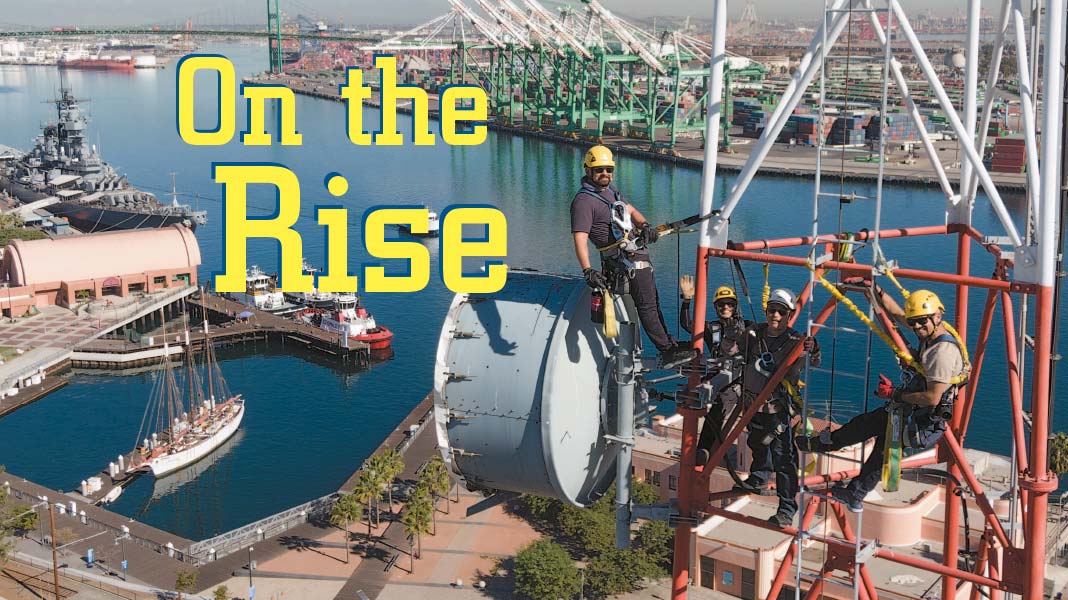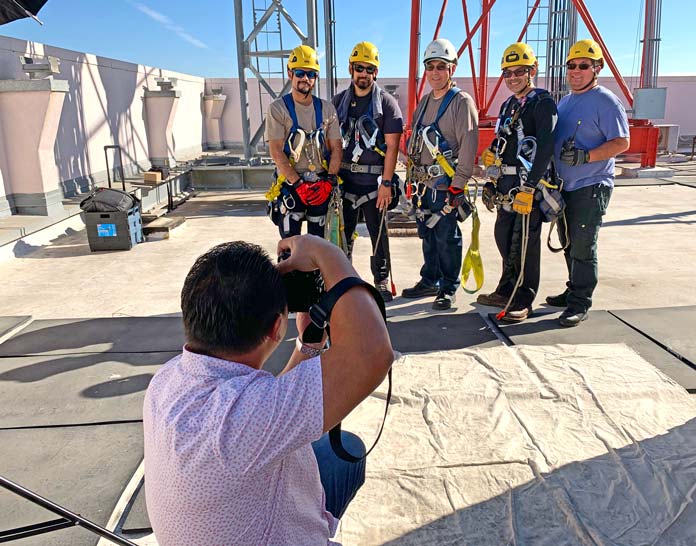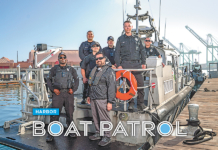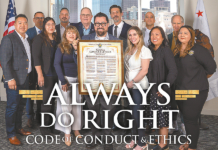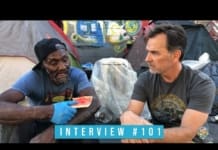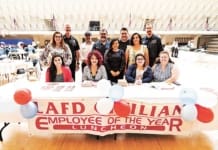Alive! photos by Summy Lam and John Burnes, and courtesy Airport Police.

City crews can be found just about everywhere from on the streets, in helicopters, in sewers, in offices high and low, in animal enclosures, and on an on.
But for this crew, you need to look … up.
The City’s Information Technology Agency has a Microwave Service Unit tasked with maintaining and repairing much of the City’s critically important long-distance communication system (the DWP maintains its own network). The system is a vast network of high towers with microwave dishes bouncing and relaying signals from City Hall to Sylmar, and from San Fernando to San Pedro, and then bringing those signals closer to the ground for hand-held radio connections. A lot of the crew’s work goes on in labs in Piper Tech building or repairing circuits, or in mobile command centers wherever there are big crowds or events to manage.
But to find their most dramatic regular work, you’ll have to look way up. Like 350 feet in the air, climbing high on one of the City’s more than 30 microwave towers. The most well recognized microwave towers are atop City Hall, above the Hollywood sign on Mt. Lee, and in San Pedro.
The small band forms the City’s primary certified tower climbers. They get to see the City from a vantage that almost no one else gets to see.
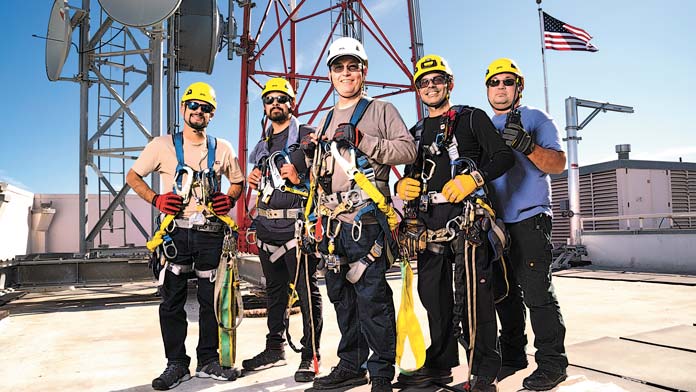
The ITA microwave service section under David DiLullo performs various services that install and maintain the microwave links that connect public safety and City department communications. Microwave is used to transport data point-to-point using the circular, shrouded microwave antennas at the top of the tower. The section handles all things microwave, including responding to critical outages, performing regular preventative maintenance and handling assigned projects across 34-plus sites. The equipment at these sites requires high climbing and dangerous work around high electrical voltage.
In this month’s feature, learn about what they do, whether they get scared up there, and just how important their task is.
![]()
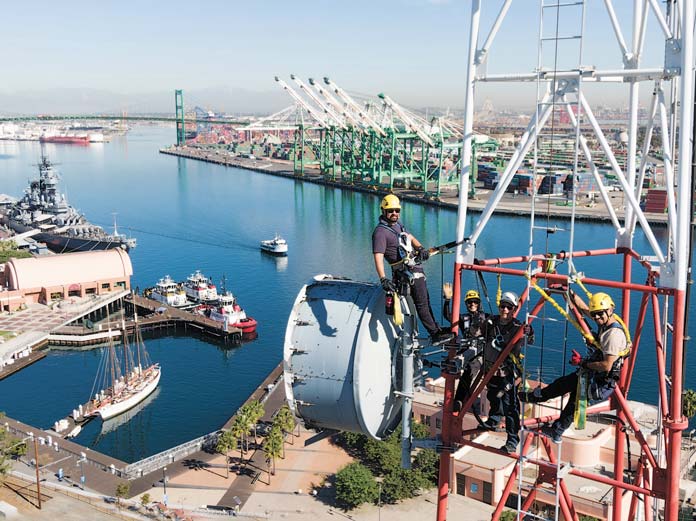
Sky-High Service
On October 24, Club CEO John Hawkins and Alive! editor John Burnes interviewed nearly ITA’s entire Microwave Radio Group, which is part of ITA’s Field Services unit. Included in this big Alive! interview were:
-
-
- Rito Cisneros, Sr. Communications Electrician Supervisor, 33 years of City service, Club Member;
- David DiLullo, Communications Electrician and Supervisor of the Microwave Radio Group, 33 years, Club Member;
- Daniel Cabrera, Engineer Associate;
- Eric Milholland, Communications Electrician, 1 year, Club Member;
- Michaelangelo Garcia, Communications Electrician, 2 years, Club Member;
- JonPaul Palacio, Communications Electrician, 1 year, Club Member;
- Virgilio Hermoso, Sr. Communications Electrician, 18 years, Club Member;
- Juliard Doneza, Communications Electrician, 3 years, Club Member; and
- Johnnie Gomez, Communications Electrician, 19 years, Club Member
-
The interview took place in the team’s headquarters space in Piper Tech downtown.
Wow, this is great having so many of you in the interview. This might be our biggest Alive! interview yet! Before we begin, we have Johnnie Gomez and Michaelangelo Garcia to thank. You two walked into the Club Store downtown and talked to Tiffany Sy, our Club Counselor there, and you told her that this unit would be good to feature in Alive! So thank you for that.
Now, who here are certified to be tower climbers?
Rito Cisneros: Our tower climbers are David DiLullo, Eric Milholland, Michael Garcia, J.P. Palacio and Johnnie Gomez.
Talk about the structure of the microwave unit. What are your responsibilities?
David DiLullo: We handle all of the microwave communication within the City boundaries – Police, Fire and any agency within the City.
Not just Fire and Police?
Virgilio Hermoso: All parts of the City communication.
Johnnie Gomez: Sanitation, too.
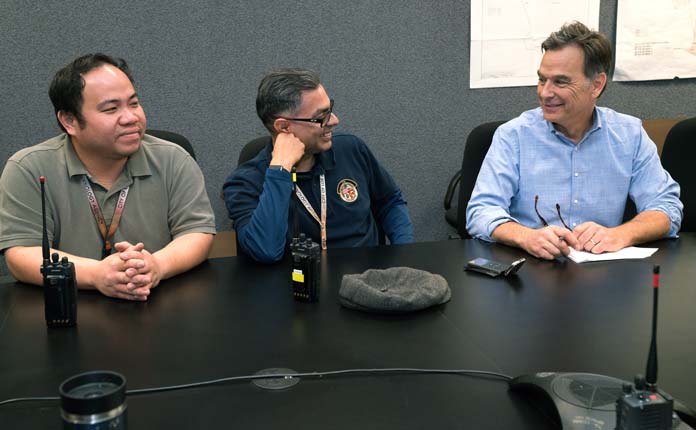
Rec and Parks?
Johnnie Gomez: Rec and Parks. The Park Rangers. The Zoo. Animal Services.
David DiLullo: Transportation. Anything under the City umbrella.
Juliard Doneza: The lifeguards too.
Virgilio Hermoso: Right. At Rec and Parks.
By maintain, you mean climb the towers to get at the equipment at all the City’s microwave towers, and fix, repair and upgrade here on the ground, too.
David DiLullo: Right. Within my group, we maintain the LAFD voice radio system and the Fire MDT [mobile data terminal] system Citywide. We had only two climbers in the past, now we have five in the group. We needed more people to go up to work on a tower. If there is a problem with the microwave equipment, we have to be able to climb and repair or replace that equipment, or make adjustments to it. Our group here is broken up into Police and the Fire specialists because of the workload.
Oh, right.
David DiLullo: The systems are so large and complex that they’re specialized. If there’s a problem with the Fire channels, then we’ll have the Fire guys take care of it. If there’s a Police microwave problem, then the Police guys will take care of it.
Got it. How many towers do you have? How many towers are you responsible for?
David DiLullo: All of them!
[Laughter in the room.]
Daniel Cabrera: We have about 30.
David DiLullo: We have mobile microwave.
For movable command centers, things like that.
Daniel Cabrera: Yes. That’s way future. Way in the future.
David DiLullo: We have three mobile microwave vehicles and two portable hops that we can set up.
Michaelangelo Garcia: In the current Alive!, you feature LAPD’s Air Support. Their sky video footage from the helicopters to the ground goes through our system as well.
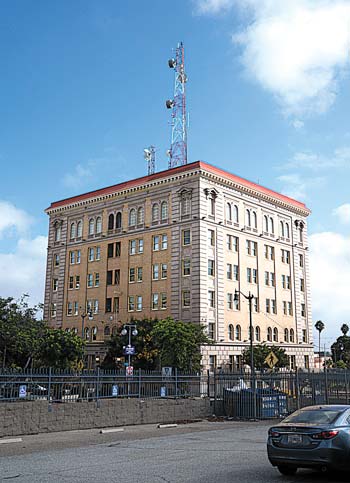
What’s the height of your towers? What’s the tallest one you maintain?
David DiLullo: Probably Mount Lee. What is it?
Daniel Cabrera: There’s a certain threshold we can’t go above.
Michaelangelo Garcia: Mt. Lee is 360 feet, including the manifold at the top.
That’s where the beacon light is?
JonPaul Palacio: The beacon and the receive antennae.
How many of you have climbed to the top of the Mt. Lee tower?
JonPaul Palacio: Just Johnnie, in this group.
You have, Johnnie?
Johnnie Gomez: Yes.
Is that something that all of you will eventually do? Or is it just left for someone who thrives on it?
Michaelangelo Garcia: I want to do it just to do it, too. To say I conquered it.
David DiLullo: We don’t climb just for climbing. We climb for a purpose.
Michaelangelo Garcia: Right, of course.
David DiLullo: The light bulbs are changed annually and they contract that out, so that’s why only one person in this group has climbed to the top on that tower.
Johnnie Gomez: We actually had a job one time at the top. David and I had to replace a down converter.
Juliard Doneza: For the video downlink.
Johnnie Gomez: So I figured I’d let my supervisor know that I was going to go to the top and replace it.
David DiLullo: Well, your Supervisor was there with you!
Johnnie Gomez: Correct. You gave me the okay to go up there.
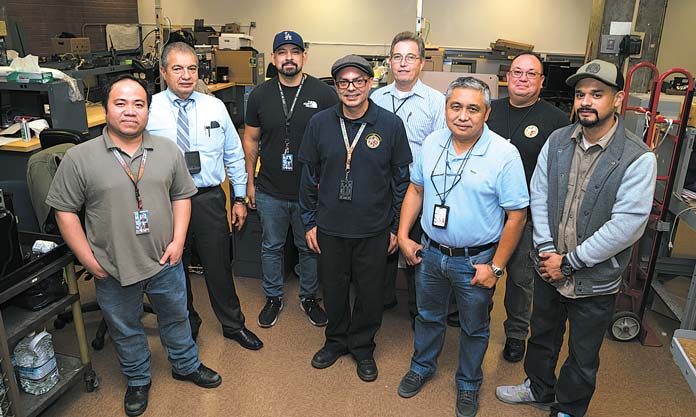
Does the City have another team like yours? Or are you unique?
David DiLullo: We are unique. We are the only field service for the City. The DWP is different.
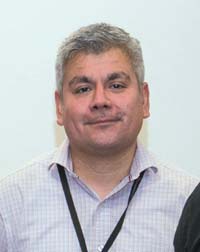
Daniel Cabrera: They have a different microwave system that that goes multiple states.
 Different Tasks
Different Tasks
It sounds like there are two sides to what you do. There are the climbers and also the employees who work here on the ground.
Rito Cisneros: They both work together. Johnnie doesn’t only climb towers. He’s not only expected to do that. He repairs and maintains the equipment. The only time they will climb the tower is if it’s necessary when we have equipment that’s down or cabling that needs to be replaced. It’s not like just one section does the climbing and this guy does only radios. They all know both sides.

Everyone has access to the repair benches and equipment here at Piper Tech?
Rito Cisneros: Yes.
David DiLullo: We do everything. Police and Fire have their own System Maintenance Operations. They are the ones who’ll give us a call and say, “Hey, we’ve got a problem with this system,” and we’ll take care of it.
Can you break down exactly what a microwave tower is and your equipment? Can you simplify the big picture?
Virgilio Hermoso: Microwave is like a freeway. We are the communications freeway – City signals travel long distances from tower to tower. And then those signals from the big dish come back down to the ground and are distributed locally through two-way radios. The microwave towers carry all the big loads.
Michaelangelo Garcia: We are the backbone of the communications infrastructure for Los Angeles City. Microwave is a point-to-point system using dishes heading from one mountaintop to another mountaintop or to a police station to move radio signals throughout the City. You’re transferring the signal from one dish to another dish to another dish to another dish, and then to the ground. When a Fire Department keys up a [portable two-way] radio, it goes through our system to get to the other person.
These aren’t the kind of radios you could buy at Big Five.
Michaelangelo Garcia: No. No. We have specialized frequencies.
Exclusive bands? No one else can jump on it?
David DiLullo: It’s FCC licensed for the City’s use. The Public Safety band. It’s a private radio system within the City.
JonPaul Palacio: We utilize the height of the towers so our antennas can communicate throughout the City. We’re limited by distance, so depending on the frequency utilized, we go point to point at a distance. It will bounce from City Hall to Mt. Lee, for example. If we need to get all the way down to San Pedro we use different towers to get down there.
This is line of sight. There can’t be anything in the way between two towers.
JonPaul Palacio: Yes. That’s why we need the height of the tower.
This might seem ridiculous, but here it is: How is this the same or different from the microwaves we have in our kitchens?
[Laughter in the room.]
You laugh. I know.
Daniel Cabrera: The difference is just the use of the frequency. In one case you’re using microwave frequency to heat your food. In the other case, we’re using microwave frequency to communicate. But either way, it’s still microwave frequencies.
David DiLullo: The microwaves we use are not high power like microwave ovens. They’re less than 1 to 2 watts of power usually on a microwave dish.
But you can’t stand in front of one your microwave dishes when you’re repairing them. You have to be behind them.
JonPaul Palacio: You shouldn’t be in front of them. You’re supposed to be three feet away from the. The microwave will go through your body at a certain power. It warms your body. It could cook you.
David DiLullo: When you’re on the tower, you don’t intentionally stand in the way of an antenna. You try to minimize that area. And most of the time on the tower, you’re standing on the middle of the tower, and the dishes are attached to the outside legs, pointing out. The dish is pointing away from you. You’re working usually behind it.
 The Repair Side
The Repair Side
What do we call this area in Piper Tech where you do most of the repairs?
Daniel Cabrera: The shop.
Who does the soldering?
Eric Milholland: Everybody.
Let’s talk about the things that happen on the ground. What do you do here in the shop?
Virgilio Hermoso: We do our repairs and maintenance here, but mostly we do reports. And then back into the field.
Do you keep spare parts?
Virgilio Hermoso: Yes. Most of the time we have to order the part, although we have a lot of spares. But sometimes – especially the legacy microwave gear – we don’t have parts for that. The manufacturer doesn’t carry it anymore. So we repair it ourselves, here.
Johnnie Gomez: Juliard is our super tech here, our bench tech.
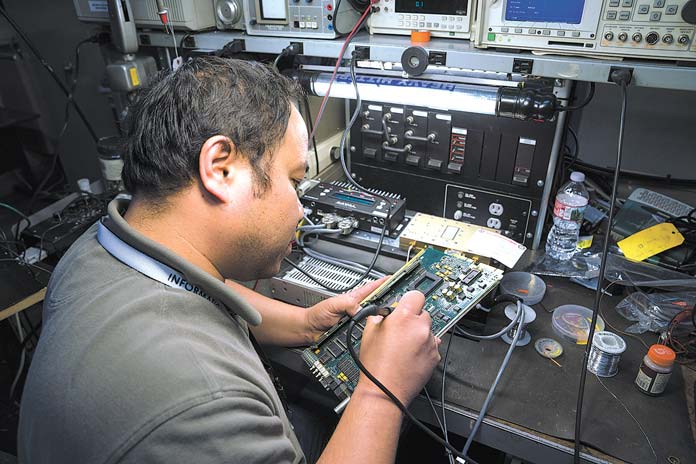
Juliard Doneza: Everybody here is a bench tech.
Johnnie Gomez: But you are a Super Tech, I’ve got to give you that.
David DiLullo: We work as a team, but we all have specialized skills that we bring to the table. We keep everything communicating within the City. We take our assignments here in the morning and then we go out into the field. But our tasks are usually at a remote site, not physically here. They’re located up at the top of Oat Mountain or Mt. Lee or one of the police stations or somewhere else. We have to travel to that site. We’re traveling most of the time.
Daniel Cabrera: I spend a lot of time in the shop working with Dave. We set up test equipment. We also do training in the shop a lot of times. We monitor our remote equipment from the shop. All of our monitoring computers are set up here in the shop, so from here we dispatch techs out into the field. We also do safety briefings here, too. We talk about how to stay safe and remind people as a refresher. These guys are masters and experts, but we all need reminders.
 System Design
System Design
What about system design? Do you have communication engineers and electricians here who design systems?
Johnnie Gomez: That’s with ITA.
Daniel Cabrera: Because these guys are primarily maintenance, which is the operational side, they’re out in the field doing the real work of what our organization is all about. But we also need to plan for future needs for customers for Police and for the Fire Department. A lot of times the engineers are out there talking to the Police and Fire Departments trying to find out what their needs are and what kind of upgrades are we might be implementing.
The World Cup is coming up. The Olympics is coming up. What kind of support do we need to provide in terms of infrastructure to support those events? Right now we’re trying to upgrade our mobile command centers so that the police can have a more active presence in the field. We’re working on that right now, actually.
I know, for Fleet Week in the Harbor, you have to set up communications with your microwave trucks for a temporary command post. Who designed that system? Who figures out all the ways the microwave signals are going to bounce from tower to tower and arrive there on the street? Who draws those thin pencil lines to figure out where everything’s bouncing and where it’s going? Who figures that all out?
Michaelangelo Garcia: Most of the time that is done by our Sr. Communications Electrician, Virgilio. He’s the man for the job.
Virgilio Hermoso: You have to figure out where you’re going to put the command post, and then the line of sight that can be used. You have to figure out where you’re dropping the signal to reach the command post.
How long does it take you to figure that all out?
Virgilio Hermoso: Maybe a couple of days.
That’s it?
Virgilio Hermoso: Yes. We already know where the microwave is coming from.
Johnnie Gomez: We recently rolled out an emergency system for the Fire Dept. for the Saddle Ridge Fire. We set it up late at night at Hansen Dam.
In an emergency situation like that, someone from your team has to be there 24/7?
Virgilio Hermoso: Yes.
David DiLullo: We have rotating shifts. We’re on call 24/7. It doesn’t matter if it’s a holiday or not, we always have two guys on call for our group.
Are there special events that you can plan for?
David DiLullo: Sure. If there are scheduled events like a USC game or a Rams, we know that we’re going to be there. If it’s an emergency, that’s when the Fire Dept. will request our services to be out there.

Virgilio Hermoso: Or a gang sweep.
I never thought of that.
David DiLullo: For extra backup for communications.
Are you ever in harm’s way?
David DiLullo: Well, typically, the command posts are in a non-threatening area. But sometimes, like in a fire, the threat can move and become more of a challenge.
 Nerves of Steel
Nerves of Steel
Okay. How do you get a job here?
JonPaul Palacio: We have previous employment that qualifies us as electricians. In my case I was a cable splicer with AT&T. Dealing with electronics gives us the minimal qualifications to get a job like this. We have specialized certifications as well. I have my FCC license and I studied in wireless technologies. So we’re able to work on the equipment safely.
Johnnie Gomez: I’m old school. David and I went to school at L.A. Trade Tech for two years, in the radio communication course. David right away started for Metro but I worked in private industry almost nine years repairing radios at the component level. You’ve got to take a test to come in here. It’s a Civil Service test. You’ve got to score high just to get that interview.
Michaelangelo Garcia: When I was 18 I started doing cable for a cable company, and then from there I went over to AT&T. I started taking courses through AT&T for my FCC fiber-splicing license, wireless LAN courses, data communications and networks, and basic electronics courses. From there I was able to take the test here. After you take the test and pass it, then you’ll do a panel interview. If you score high, you get placed on an eligible list. If there’s a vacancy for a communication electrician in a department and you’re next on the list, you have to interview again. And if goes well, they pick you up.
Is climbing a tower something that you had to think about? Is that part of the interview process?
Michaelangelo Garcia: It depends on the group that you’re in. When I started here, my supervisor, David DiLullo, asked me if I would like to climb towers. I was used to pole climbing. I’d been pole climbing since I was 18 years old for the cable company. I’m not afraid of heights or climbing up there.
David DiLullo: It’s not a requirement.
Virgilio Hermoso: It’s voluntary.
But you have to have enough people that are capable of doing that.
David DiLullo: Right, you have to.
Michaelangelo Garcia: Originally there weren’t enough people to climb within the Microwave Group, so that’s why different sections in ITA have climbers as well. But now that we’re getting new guys in who have climbing experience or who are willing to climb, we are able to respond quickly.
David DiLullo: Everybody is always busy. When you need something fixed, you need it fixed now and not tomorrow or the next day.
Does the climbing get harder?
David DiLullo: As you get older? Yes.
Johnnie Gomez: I’m 50 years old and I feel strong. It’s not a big deal. I’m going to keep going at it. I have maybe 12 to 15 more years to go. I enjoy it. It feels good.
You have to be certified to climb, right?
David DiLullo: We keep a certification for tower climbing and then we do an additional CPR certification in case something happens and you have to be the first responder.
Safety must be a big deal.
Johnnie Gomez: You have to take a lot of safety precautions. That’s the number one goal. You want to come home to your family. You’ve got to be safe, 100 percent. We have a tie-off – we’re always hooked, no matter what.
Michaelangelo Garcia: One-hundred percent tie-off. You have multiple different pieces of safety equipment when you attach yourself to the tower. The key is 100 percent tie-off, and when you’re climbing you always need three points of contact – one foot and two hands on whatever you’re climbing, or two feet and one hand. As you’re going up it’s called a three point contact rule.
It’s very scientific how you climb these towers. A methodology to it.
Michaelangelo Garcia: The fear is going to be there, but you can’t really fully have fear because if you’re second guessing yourself you’re going to make a mistake. You still have to be confident in what you’re doing as well, but at the same time being safe.
But also to touch on what Johnnie said, it’s not just the height of the tower – you also have to think of where that tower is. It’s already sitting on a mountaintop. It’s more elevation than just the tower. It gets pretty high up there!
Can you take anything with you, like water?
Michaelangelo Garcia: You can take water. We take tools up there. Sometimes those harnesses get pretty heavy because you have to think of all the hooks and things that you’re already carrying and all the safety gear you’re already carrying. It can get pretty heavy.
Are there wind limits?
Johnnie Gomez: Yes. Twenty-five miles per hour. But it’s a personal decision.
David DiLullo: A personal decision. Lightning is one of the things you don’t want to be in a tower.
Johnnie Gomez: You feel the wind. It’s a lot of wind blowing at you.
David DiLullo: Your skin gets dried out and you can get sore. It’s a sun and windburn thing.
Johnnie Gomez: We have to deal with the elements out there. We have to be careful of rattlesnakes.
Virgilio Hermoso: Fog.
Johnnie Gomez: The fog. It’s dangerous.
Virgilio Hermoso: Sometimes when you go up the mountain, it’s like zero visibility and you need to get out of your car sometimes just to see if the road’s still there.
Johnnie Gomez: We’ll do our best to make it up there.
David DiLullo: You go up the hill and your headlights go into the fog, and you just see nothing. And you’re hoping there’s ground on the other side of that hill.
 Seeing Forever
Seeing Forever
What’s it like at the top of these towers? What’s the City look like from up there?
Johnnie Gomez: Exhilarating. It’s a wonderful feeling. You look around and it’s beautiful. I wish we could go higher!
[Laughter in the room.]
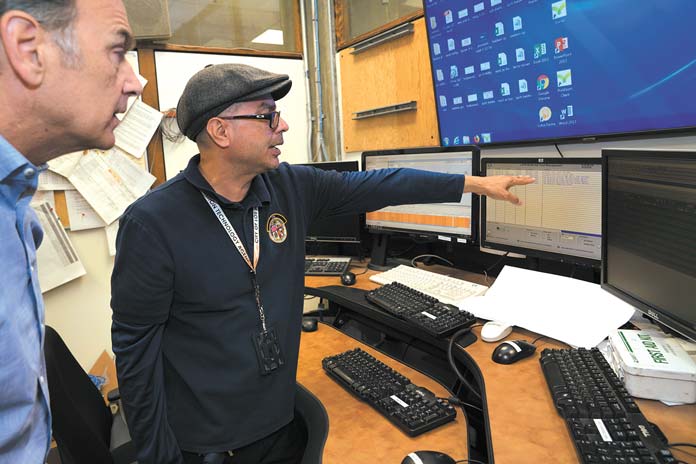
Is it worth the effort to climb to the top?
Johnnie Gomez: Very. I encourage anyone who wants to and can do it, to do it.
JonPaul Palacio: I recently had a chance to go up to Verdugo Tower and just it makes you feel how small you are in the City. Everything looks like a little movie set.
Michaelangelo Garcia: A toy.
JonPaul Palacio: Yes. It really puts things in perspective to look to the end of the horizon and look all around 360 degrees and realize just how small we are down there and how vital City communications are.
What do you wish people knew about what you do?
Michaelangelo Garcia: I want people to know that we are providing service to public safety. For the first responders to do their job, our infrastructure needs to be functioning in order for them to be able to communicate. So that’s kind of what I would want people to know, that, you know, we are the…
David DiLullo: The backbone.
Michaelangelo Garcia: … yes, the unseen guys in the background who play a major role in public safety.
Yeah.
Eric Milholland: Without us, the entire City would not be able to communicate the way they do. A Police Officer can talk on a walkie-talkie from San Pedro all the way to Burbank Airport, and that’s going to happen because of our backbone system.
Juliard Doneza: The microwave for the City interconnects all the agencies. We are rated “five-9s.”
What’s that?
Juliard Doneza: Five 9s – 99.999 percent availability. Every day.
I had never heard that before, five 9s.
Juliard Doneza: That’s the word in public safety.
Good to know that! Well, anyway, this has been a great interview, gentlemen. Thanks for all your information, and we’re looking forward to seeing more of your photos.
David DiLullo: Anytime. And thank you.
BEHIND THE SCENES
Club Director of Marketing Summy Lam (foreground) photographs the ITA Microwave Crew preparing for an inspection above the San Pedro City Hall. |


